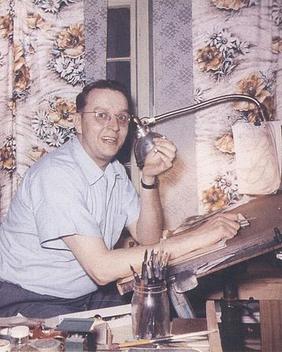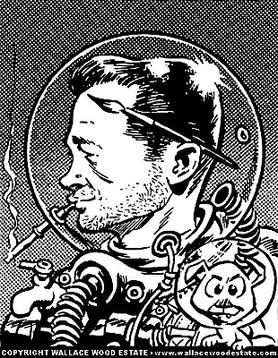
William Erwin Eisner was an American cartoonist, writer, and entrepreneur. He was one of the earliest cartoonists to work in the American comic book industry, and his series The Spirit (1940–1952) was noted for its experiments in content and form. In 1978, he popularized the term "graphic novel" with the publication of his book A Contract with God. He was an early contributor to formal comics studies with his book Comics and Sequential Art (1985). The Eisner Award was named in his honor and is given to recognize achievements each year in the comics medium; he was one of the three inaugural inductees to the Will Eisner Comic Book Hall of Fame.

Jack Ralph Cole was an American cartoonist best known for birthing the comedic superhero Plastic Man, and his cartoons for Playboy magazine.
A graphic novel is a long-form work of sequential art. The term graphic novel is often applied broadly, including fiction, non-fiction, and anthologized work, though this practice is highly contested by comics scholars and industry professionals. It is, at least in the United States, typically distinct from the term comic book, which is generally used for comics periodicals and trade paperbacks.

Peter Bagge is an American cartoonist whose best-known work includes the comics Neat Stuff and Hate. His stories often use black humor and exaggerated cartooning to dramatize the reduced expectations of middle-class American youth. He won two Harvey Awards in 1991, one for best cartoonist and one for his work on Hate. In recent decades Bagge has done more fact-based comics, everything from biographies to history to comics journalism. Publishers of Bagge's articles, illustrations, and comics include suck.com, MAD Magazine, toonlet, Discover, and the Weekly World News, with the comic strip Adventures of Batboy. He has expressed his libertarian views in features for Reason.

Kim Deitch is an American cartoonist who was an important figure in the underground comix movement of the 1960s, remaining active in the decades that followed with a variety of books and comics, sometimes using the pseudonym Fowlton Means.

James Kochalka is an American comic book artist, writer, animator, and rock musician. His comics are noted for their blending of the real and the surreal. Largely autobiographical, Kochalka's cartoon expression of the world around him includes such real-life characters as his wife, children, cat, friends and colleagues, but always filtered through his own observations and flights of whimsy. In March 2011 he was declared the cartoonist laureate of Vermont, serving a term of three years.

Wallace Allan Wood was an American comic book writer, artist and independent publisher, widely known for his work on EC Comics's titles such as Weird Science, Weird Fantasy, and MAD Magazine from its inception in 1952 until 1964, as well as for T.H.U.N.D.E.R. Agents, and work for Warren Publishing's Creepy. He drew a few early issues of Marvel's Daredevil and established the title character's distinctive red costume. Wood created and owned the long-running characters Sally Forth and Cannon.

The Spirit is a fictional masked crimefighter appearing in American comic books. Created by cartoonist Will Eisner, he first appeared as the main feature of a tabloid-sized comic book insert distributed in the Sunday edition of Register and Tribune Syndicate newspapers. Popularly referred to as "The Spirit Section", the insert ran from June 2, 1940 to October 5, 1952.

Jeff Smith is an American cartoonist. He is best known as the creator of the self-published comic book series Bone.

Kyle John Baker is an American cartoonist, comic book writer-artist, and animator known for his graphic novels and for a 2000s revival of the series Plastic Man.

John Backderf, also known as Derf or Derf Backderf, is an American cartoonist. He is most famous for his graphic novels, especially My Friend Dahmer, the international bestseller which won an Angoulême Prize, and earlier for his comic strip The City, which appeared in a number of alternative newspapers from 1990 to 2014. In 2006 Derf won the Robert F. Kennedy Journalism Award for cartooning. Backderf has been based in Cleveland, Ohio, for much of his career.

Irwin Hasen was an American cartoonist best known as the creator of the Dondi comic strip. He also had a significant run on DC Comics' original Green Lantern, Alan Scott, in the 1940s as well as creating Wildcat for the same publisher.

Creig Valentine Flessel was an American comic book artist and an illustrator and cartoonist for magazines ranging from Boys' Life to Playboy. One of the earliest comic book illustrators, he was a 2006 nominee for induction into the comics industry's Will Eisner Hall of Fame.
Nicole Hollander is an American cartoonist and writer. Her daily comic strip Sylvia was syndicated to newspapers nationally by Tribune Media Services.

Batton Lash was an American comics creator who came to prominence as part of the 1990s self-publishing boom. He is best known for the series Wolff and Byrd, Counselors of the Macabre, a comedic series about law partners specializing in cases dealing with archetypes from the horror genre, which ran as a strip in The National Law Journal, and as a stand-alone series of comic books and graphic novels. He received several awards for his work, including an Inkpot Award, an Independent Book Publishers Association's Benjamin Franklin Award, an Eisner Award, and nominations for two Harvey Awards.
Munro is a 1960 Czechoslovak-American animated short film directed by Gene Deitch, written by Jules Feiffer, and produced by William L. Snyder. Munro won an Oscar for Best Animated Short Film in 1961. It was the first short composed outside of the United States to be so honored. The Academy Film Archive preserved Munro in 2004.

The Billy Ireland Cartoon Library & Museum is a research library of American cartoons and comic art affiliated with the Ohio State University library system in Columbus, Ohio. Formerly known as the Cartoon Research Library and the Cartoon Library & Museum, it holds the world's largest and most comprehensive academic research facility documenting and displaying original and printed comic strips, editorial cartoons, and cartoon art. The museum is named after the Ohio cartoonist Billy Ireland.
Comics has developed specialized terminology. Several attempts have been made to formalize and define the terminology of comics by authors such as Will Eisner, Scott McCloud, R. C. Harvey and Dylan Horrocks. Much of the terminology in English is under dispute, so this page will list and describe the most common terms used in comics.

Edward R. Piskor Jr. was an American alternative comics cartoonist. Piskor was known primarily for his work on Hip Hop Family Tree, X-Men: Grand Design, and the Red Room trilogy. Piskor also co-hosted the YouTube channel Cartoonist Kayfabe with fellow Pittsburgh native cartoonist Jim Rugg. In March 2024, Piskor was accused via social media of sexual misconduct. Piskor died on April 1, 2024, at the age of 41, hours after posting a suicide note via social media, defending himself against the allegations leveled against him.




















